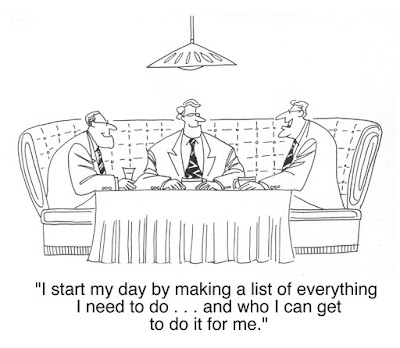Ah, wouldn’t it be easy just to tell people what to do and then go off to lunch with friends?
The leader in this cartoon seems to think he’s an expert at delegating…after all, he has left a list of to-do’s for his team. But we would say in our situational leadership training that he has, in many ways, forfeited his true responsibility as a leader. He has not remained available for his followers’ questions and concerns. He has left the “scene of the crime” without someone in charge to solve problems and guide team members. And he has probably not set clear expectations or worked toward shared commitment. He is acting more like a dictator than a true situational leader.
One of the basic tenets of great leadership is maintaining accountability. And this holds true for leaders as well as followers. Leaders should be accountable for achieving their team goals. Followers should be held accountable for achieving their individual goals…goals that were established in discussions with their manager in the context of what the team needs to achieve. There is, however, an additional wrinkle. It is the manager’s responsibility to make sure the team members are committed to delivering the desired results. It is the manager’s responsibility to make sure the team members have the competence required to deliver the desired results in a way that makes sense.
The best leaders understand that they can’t hold workers responsible for a task they don’t know how to do – i.e. a low level of competence. This is when managers must offer opportunities for development and be ready to coach and supervise as the employee begins to practice the new skills. In this situation, the leader is accountable for the employee’s performance.
By the same token, when an employee has the skills, they are the ones who should be held accountable. Their leader recognizes them as able and gives them the right to personal accountability. This means that given the task, they can figure out how to accomplish it without their manager’s active engagement and frequent check-ins.
With this in mind, let’s take a second look at the cartoon. It is possible that the speaker has effectively trained, developed and coached his team in a way that they are ready to take on their own accountability. If so, he does not need to micromanage and deserves a break with his colleagues.
Learn more at: http://www.lsaglobal.com/situational-leadership-training-consulting/


No comments:
Post a Comment